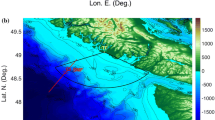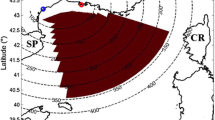Abstract
The combination of a high-frequency ocean surface radar and a tsunami detection method should be assessed as the onshore-offshore distribution of tsunami detection probability, because the probability will vary in accordance with the signal-to-noise ratio (SNR) and the tsunami magnitude in addition to the radar system specifications. Here, we statistically examine the tsunami detection distance based on virtual tsunami observation experiments by using signals received by a high-frequency radar in February 2014 installed on the southern coast of Japan and numerically simulated velocities induced by a Nankai Trough earthquake. In the experiments, the Doppler frequencies associated with the simulated velocities were superimposed on the receiving signals of the radar, and the radial velocities were calculated from the synthesized signals by the fast Fourier transform. Tsunami arrival was then detected based on the temporal change in the cross-correlation of the velocities, before and after tsunami arrival, between two points 3 km apart along a radar beam. We found that the possibility of tsunami detection primarily depends on the kinetic energy ratio between tsunami current and background current velocities. The monthly average detection probability is over 90% when the energy ratio exceeds 5 (offshore distance: 9 km ≤ L ≤ 36 km) and reduces to 50% when the energy ratio is approximately 1 (L = 42 km) over the shelf slope. The ratio varied with the background current physics and SNR, which was mainly affected by ocean surface wave heights and ionospheric electron density.












Similar content being viewed by others
References
Barrick D (1971) Theory of HF and VHF propagation across the rough sea, 2, application to HF and VHF propagation above the sea. Radio Sci 6(5):527–533
Barrick D (1979) A coastal radar system for tsunami warning. Remote Sens Environ 8:353–358
Dzvonkovskaya A (2012) Ocean surface current measurements using HF radar during the 2011 Japan tsunami hitting Chilean coast. In 2012 IEEE International Geoscience and Remote Sensing Symposium, pp 7605–7608. doi:10.1109/IGARSS.2012.6351867
Dzvonkovskaya A, Figueroa D, Gurgel KW, Rohling H, Schlick T (2011) HF radar observation of a tsunami near Chile after the recent great earthquake in Japan. 12th International Radar Symposium, Leipzig, Germany, pp 125–130
Fuji R, Hinata H, Fujii S, Nagamatsu H, Ogasawara I, Ito H, Kataoka T, Takahashi T (2015) Tsunami detection based on virtual tsunami observation experiment by using oceanographic radar. J Jpn Soc Civil Eng Ser B2 (Coastal Engineering) 71:337–342 (in Japanese with English abstract)
Goto C, Ogawa Y, Shuto N, Imamura F (1997) IUGG/IOC time project: Numerical method of tsunami simulation with the leap-frog scheme. Intergov Oceanogr Comm Man Guides 35
Grilli ST, Grosdidier S, Guerin CA (2015) Tsunami detection by high-frequency radar beyond the continental shelf. Pure Appl Geophys. doi:10.1007/s00024-015-1193-8
Grilli ST, Shelby M, Grilli AR, Guérin CA, Grosdidier S, Lado IT (2016) Algorithms for tsunami detection by high frequency radar: development and case studies for tsunami impact in British Columbia, Canada. In: Proceedings of the 26th Offshore and Polar Engineering Conference (ISOPE16, Rodos, Greece, June 2016), International Society of Offshore and Polar Engineers, pp 807–814. http://personal.egr.uri.edu/grilli/Grilli_etal_2016_HFradar.pdf.. Accessed 1 Nov 2016
Gurgel KW, Dzvonkovskaya A, Pohlmann T, Schlick T, Gill EW (2011) Simulation and detection of tsunami signatures in ocean surface currents measured by HF radar. Ocean Dyn 61(10):1495–1507. doi:10.1007/s10236-011-0420-9
Hinata H, Fujii S, Furukawa K, Kataoka T, Miyata M, Kobayashi T, Mizutani M, Kokai T, Kanatsu N (2011) Propagating tsunami wave and subsequent resonant response signals detected by HF radar in the Kii Channel, Japan. Estuary Coast Shelf S 95(1):268–273. doi:10.1016/j.ecss.2011.08.009
Hinata H, Fuji R, Fujii S, Fujita Y, Hanado H, Kataoka T, Mizutani M, Takahashi T (2012) HF radar observation of velocity fields induced by tsunami waves in the Kii channel, Japan. J Jpn Soc Civil Eng Ser B2 (Coastal Engineering) 68:196–200 (in Japanese with English abstract)
Imai K, Satake K, Furumura T (2010) Amplification of tsunami heights by delayed rupture of great earthquakes along the Nankai trough. Earth Planets Space 62(4):427–432. doi:10.5047/eps.2009.12.005
Ishii M (2009) Studies of ionospheric variations for radio propagation. J Natl Inst Inf Commun Technol 56(1–4):223–229
Lipa B, Barrick D, Bourg J, Nyden B (2006) HF radar detection of tsunamis. J Oceanogr 62:705–716. doi:10.1007/s10872-006-0088-9
Lipa B, Barrick D, Saitoh S, Ishikawa Y, Awaji T, Largier J, Garfield N (2011) Japan tsunami current flows observed by HF radars on two continents. Remote Sens 3(8):1663–1679. doi:10.3390/rs3081663
Lipa B, Isaacson J, Nyden B, Barrick D (2012a) Tsunami arrival detection with high frequency (HF) radar. Remote Sens 4(5):1448–1461. doi:10.3390/rs4051448
Lipa B, Barrick D, Diposaptono S, Isaacson J, Jena BK, Nyden B, Rajesh K, Kumar TS (2012b) High frequency (HF) radar detection of the weak 2012 Indonesian tsunamis. Remote Sens 4(10):2944–2956. doi:10.3390/rs4102944
Lipa B, Parikh H, Barrick D, Roarty H, Glenn S (2014) High-frequency radar observations of the June 2013 US East Coast meteotsunami. Nat Hazards 74(1):109–122. doi:10.1007/s11069-013-0992-4
Okada Y (1992) Internal deformation due to shear and tensile faults in a half-space. Bull Seismol Soc Am 82(2):1018–1040
Rohling H (1983) Radar CFAR thresholding in clutter and multiple target situations. IEEE Trans Aerosp Electron Syst AES 19:608–621
Seto S, Takahashi T (2015) Examination on the observation site of oceanographic radar for tsunami source and propagation in the Nankai trough. J Jpn Soc Civil Eng Ser B2 (Coastal Engineering) 71:343–348 (in Japanese with English abstract)
Sugawara D, Goto K (2012) Numerical modeling of the 2011 Tohoku-oki tsunami in the offshore and onshore of Sendai Plain, Japan. Sediment Geol 282:110–123. doi:10.1016/j.sedgeo.2012.08.002
Takahashi T, Takahashi T, Shuto N, Imamura F, Ortiz M (1995) Source models for the 1993 Hokkaido Nansei-Oki earthquake tsunami. Pure Appl Geophys 144:747–767. doi:10.1007/BF00874393
Acknowledgements
This research was supported by a collaborative research project between Ehime University and Kokusai Kogyo Co., Ltd., the Mitsubishi Foundation, JSPS Grant-in-Aid for Scientific Research (KAKENHI) number 16H04419, and MIC/SCOPE grant number 165011003. We are grateful to Dr. Takahashi and Dr. Fujii for helpful discussions.
Author information
Authors and Affiliations
Corresponding author
Rights and permissions
About this article
Cite this article
Fuji, R., Hinata, H. Temporal variability of tsunami arrival detection distance revealed by virtual tsunami observation experiments using numerical simulation and 1-month HF radar observation. J Oceanogr 73, 725–741 (2017). https://doi.org/10.1007/s10872-017-0428-y
Received:
Revised:
Accepted:
Published:
Issue Date:
DOI: https://doi.org/10.1007/s10872-017-0428-y




